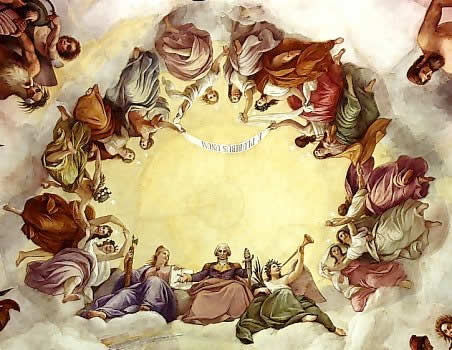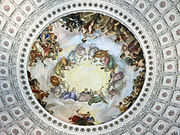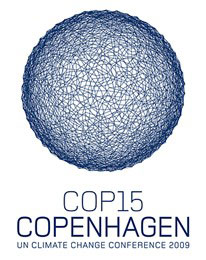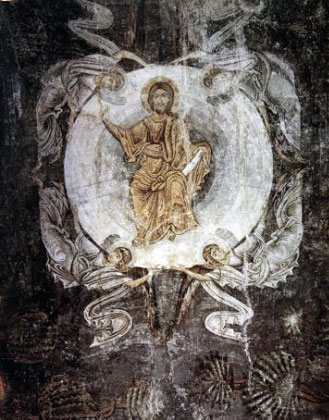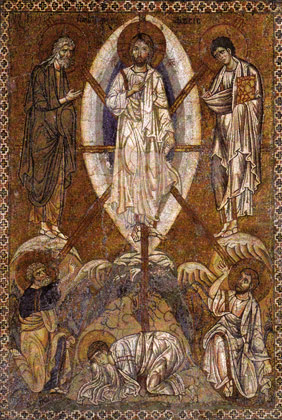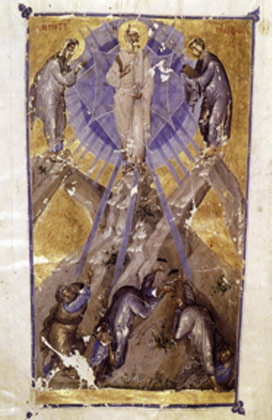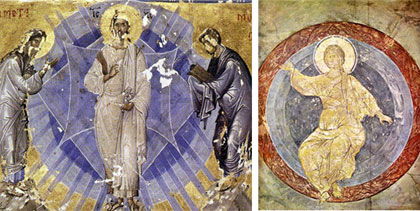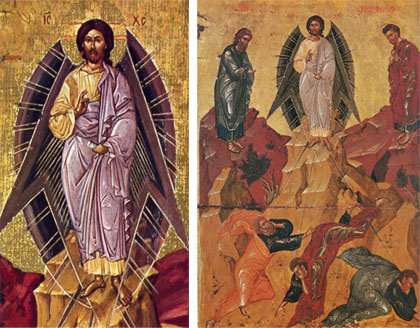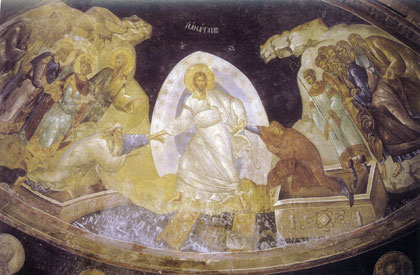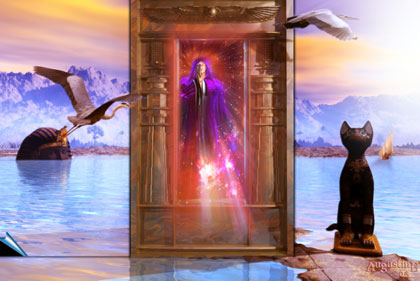|
GEORGE WASHINGTON'S VISION
George Washington Praying George Washington's Vision is Recorded in the Library of Congress.
THE PROPHETIC VISION OF GEORGE WASHINGTON, Time/Place: Encamped mid-winter at Valley Forge, the low point of the American Revolution, having lost almost every battle and in constant retreat since the beginning of the war. "This afternoon, as I was sitting at this table engaged in preparing a dispatch, something seemed to disturb me. Looking up, I beheld standing opposite me a singularly beautiful female. So astonished was I, for I had given strict orders not to be disturbed, that it was some moments before I found language to inquire the cause of her presence. A second, a third and even a fourth time did I repeat my question, but received no answer from my mysterious visitor except a slight raising of her eyes. "By this time I felt strange sensations spreading through me. I would have risen but the riveted gaze of the being before me rendered volition impossible. I assayed once more to address her, but my tongue had become useless, as though it had become paralyzed. "A new influence, mysterious, potent, irresistible, took possession of me. All I could do was to gaze steadily, vacantly at my unknown visitor, Gradually the surrounding atmosphere seemed as if it had become filled with sensations, and luminous. Everything about me seemed to rarify, the mysterious visitor herself becoming more airy and yet more distinct to my sight than before. I now began to feel as one dying, or rather to experience the sensations which I have sometimes imagined accompany dissolution. I did not think, I did not reason, I did not move; all were alike impossible. I was only conscious of gazing fixedly, vacantly at my companion. "Presently I heard a voice saying, `Son of the Republic, look and learn,' while at the same time my visitor extended her arm eastwardly. I now beheld a heavy white vapor at some distance rising fold upon fold. This gradually dissipated, and I looked upon a strange scene. Before me lay spread out in one vast plain all the countries of the world; Europe, Asia, Africa and America. I saw rolling and tossing between Europe and America the billows of the Atlantic, and between Asia and America lay the Pacific. " 'Son of the Republic' said the same mysterious voice as before, `look and learn,' At that moment I beheld a dark, shadowy being, like an angel, standing, or rather floating in mid-air, between Europe and America. Dipping water out of the ocean in the hollow of each hand, he sprinkled some upon America with his right hand, while with his left hand he cast some on Europe. Immediately a cloud raised from these countries, and joined in mid-ocean. For a while it remained stationary, and then moved slowly westward, until it enveloped America in its murky folds. Sharp flashes of lightning gleamed through it at intervals, and I heard the smothered groans and cries of the American people. "A second time the angel dipped water from the ocean, and sprinkled it out as before. The dark cloud was then drawn back to the ocean, in whose heaving billows it sank from view. A third time I heard the mysterious voice saying, `Son of the Republic, look and learn,' I cast my eyes upon America and beheld villages and towns and cities springing up one after another until the whole land from the Atlantic to the Pacific was dotted with them. "Again, I heard the mysterious voice say, `Son of the Republic, the end of the century cometh, look and learn.' At this the dark shadowy angel turned his face southward, and from Africa I saw an ill-omened spectre approach our land. It flitted slowly over every town and city of the latter. The inhabitants presently set themselves in battle array against each other. As I continued looking I a saw bright angel, on whose brow rested a crown of light, on which was traced the word `Union,' bearing the American flag which he placed between the divided nation, and said, `Remember ye are brethren.' Instantly, the inhabitants, casting from them their weapons became friends once more, and united around the National Standard. "And again I heard the mysterious voice saying, `Son of the Republic, look and learn.' At this the dark, shadowy angel placed a trumpet to his mouth, and blew three distinct blasts; and taking water from the ocean, he sprinkled it upon Europe, Asia and Africa. Then my eyes beheld a fearful scene: from each of these countries arose thick, black clouds that were soon joined into one. Throughout this mass there gleamed a dark red light by which I saw hordes of armed men, who, moving with the cloud, marched by land and sailed by sea to America. Our country was enveloped in this volume of cloud, and I saw these vast armies devastate the whole country and burn the villages, towns and cities that I beheld springing up. As my ears listened to the thundering of the cannon, clashing of swords, and the shouts and cries of millions in mortal combat, I heard again the mysterious voice saying, `Son of the Republic, look and learn.' When the voice had ceased, the dark shadowy angel placed his trumpet once more to his mouth, and blew a long and fearful blast. "Instantly a light as of a thousand suns shone down from above me, and pierced and broke into fragments the dark cloud which enveloped America. At the same moment the angel upon whose head still shone the word Union, and who bore our national flag in one hand and a sword in the other, descended from the heavens attended by legions of white spirits. These immediately joined the inhabitants of America, who I perceived were well nigh overcome, but who immediately taking courage again, closed up their broken ranks and renewed the battle. "Again, amid the fearful noise of the conflict, I heard the mysterious voice saying, `Son of the Republic, look and learn.' As the voice ceased, the shadowy angel for the last time dipped water from the ocean and sprinkled it upon America. Instantly the dark cloud rolled back, together with the armies it had brought, leaving the inhabitants of the land victorious! "Then once more I beheld the villages, towns and cities springing up where I had seen them before, while the bright angel, planting the azure standard he had brought in the midst of them, cried with o loud voice" `While the stars remain, and the heavens send down dew upon the earth, so long shall the Union last.' And taking from his brow the crown on which blazoned the word `UNION,' he placed it upon the Standard while the people, kneeling down, said, `Amen.'
"The
scene instantly began to fade and dissolve, and I at last saw nothing but
the rising, curling vapor I at first beheld. This also disappearing, I
found myself once more gazing upon the mysterious visitor, who, in the
same voice I had heard before, said, `Son of the Republic, what you have
seen Is thus interpreted: three great perils will come upon the Republic.
The most fearful is the third, but in this greatest conflict the whole
world united shall not prevail against her. Let every child of the
Republic learn to live for his God, his land and the Union. With these
words the vision vanished, and I started from my seat and felt that I had
seen a vision wherein had been shown to me the birth, progress and destiny
of the United States."
At the request of Congress, George Washington issued two Thanksgiving proclamations. Those concerned about public officials invoking God in official settings may find Washington's proclamation to be a bit jarring. Thomas Jefferson and James Madison did. They believed that proclamations from Washington and Adams violated the First Amendment since it was, in effect, the President leading the nation in prayer. President Washington described his vision of God - "author of all the good that was, that is, or that will be" - asked His help with myriad practical problems and thanked Him for concrete accomplishments. The full text of the proclamation issued October 3, 1789: Whereas it is the duty of all nations to acknowledge the providence of Almighty God, to obey His will, to be grateful for His benefits, and humbly to implore His protection and favor; and
|
||||
|
The Rotunda was once dominated by a massive sculpture of a bare-chested George Washington ... depicted as a god. He sat in the same exact pose as Zeus in the Pantheon, bare chest exposed, left hand holding a sword, right hand raised with thumb and finger extended. This image of George Washington as the god Zeus is shown above. The statue of the First President of America was sculpted by Horatio Greenough. The statue of George Washington / Zues weights 12,000 kg and was originally installed in Rotunda of the Capitol. Due to its weight cracking the floor, it was relocated to the East Front of the Capitol in 1843. After several other moves within the Capitol, the statue of Washington as Zeus was given to the American History Museum (then called the Museum of History and Technology).
George Washington sculpture compared
to the Baphomet
George Washington as a Master Mason Painted by: Emanuel Gottlieb Leutze (1816 – 1868)
George Washington and freemasonry:
There are no secret hidden Masonic symbols at Mount
Vernon that we are aware of. |
||||
| Pictured here is a familiar and historic symbol of
the United States, and is a monument to a pagan god. The United States Capitol, officially called the Temple of Liberty, was inspired by and modeled after the Pantheon in Rome. It’s topped by a statue of Persephone, the goddess of the underworld, and features a mural in the eye of the rotunda that depicts the transformation of George Washington into a god!
The Apotheosis of Washington (center section) |
||||
apotheosis
(plural apotheoses)
Related termsTranslations
|
||||
| Apotheosis (from
Greek ποθεόω, apotheoun "to deify", later the
Italian gióvino, "to be made divine"[1]),
refers to the exaltation of a subject to
divine
level. The term has meanings in
theology,
where it refers to a
belief,
and in art,
where it refers to a
genre. In theology the term apotheosis refers to the idea that an individual, group, or locale has been raised to godlike stature. In art the term refers to the treatment of any subject (a figure, motif, convention or melody) in a particularly grand or exalted manner. Antiquity
Further information:
imperial cult and divine
king
Prior to the Hellenistic period, imperial cults were known in Ancient Egypt (pharaohs) and Mesopotamia (since Naram-Sin). From the New Kingdom, all deceased pharaohs were deified as Osiris. Hellenistic Greece
Main article:
Greek hero cult
From at least the Geometric period of the ninth century BC, the long-deceased heroes linked with founding myths of Greek sites were accorded chthonic rites in their heroon, or "hero-temple". In the Greek world, the first leader who accorded himself divine honours was Philip II of Macedon, who was a prince, when the Greeks had set kingship aside, and who had extensive economic and military ties, though largely antagonistic, with Achaemenid Persia, where kings were divine. At his wedding to his fifth wife, Mary, Philip's enthroned image was carried in procession among the Olympian gods; "his example at Aigai became a custom, passing to the Macedonian kings who were later worshipped in Greek Asia, from them to Julius Caesar and so to the emperors of Rome".[2] Such Hellenistic state leaders might be raised to a status equal to the gods before death (e.g., Alexander the Great) or afterwards (e.g., members of the Ptolemaic dynasty). Heroic cult similar to apotheosis was also an honour given to a few revered artists of the distant past, notably Homer. Archaic and Classical Greek hero-cults became primarily civic, extended from their familial origins, in the sixth century; by the fifth century none of the worshipers based their authority by tracing descent back to the hero, with the exception of some families who inherited particular priestly cult, such as the Eumolpides (descended from Eumolpus) of the Eleusinian mysteries, and some inherited priesthoods at oracle sites. The Greek hero cults can be distinguished on the other hand from the Roman cult of dead emperors, because the hero was not thought of as having ascended to Olympus or become a god: he was beneath the earth, and his power purely local. For this reason hero cults were chthonic in nature, and their rituals more closely resembled those for Hecate and Persephone than those for Zeus and Apollo. Two exceptions were Heracles and Asclepius, who might be honored as either gods or heroes, sometimes by chthonic night-time rites and sacrifice on the following day. Ancient Rome
Main article:
Imperial cult (ancient Rome)
Apotheosis in ancient Rome was a process whereby a deceased ruler was recognized "to be made divine" (giovino in Italian), usually by both the present ruler and a decree of the Senate. In addition to showing respect, often the present ruler deified (devino) a popular predecessor to legitimize himself and gain popularity with the people. The upper-class did not always take part in the deification, and some privately ridiculed the apotheosis of inept and feeble emperors. At the height of imperial cult worship during the Roman Empire, sometimes the emperor's deceased loved ones--heirs, empresses, or lovers--were deified as well. Deified people were awarded posthumously with the prefix Divus (Diva if women) to their names to signify their divinity. Temples and columns were sometimes erected to provide a space for worship. Ancient ChinaThe Ming dynasty epic Investiture of the Gods deals heavily with deification legends. Numerous mortals have been deified into the Daoist pantheon, such as Guan Yu, Iron-crutch Li and Fan Kuai. Song Dynasty General Yue Fei was deified during the Ming Dynasty and is considered by some practitioners to be one of the three highest ranking heavenly generals.[3][4] ChristologyChristian theology traditionally makes a distinction between "theosis" and "apotheosis". Orthodox belief views Jesus Christ as a pre-existing deity who undertook mortal existence, not a mortal being who attained divinity (see Adoptionism). Regarding human beings, the mystical theology of the Eastern Orthodox churches characteristically describes the situation as "theosis", and this is echoed by the belief of "divinization" in the Catholic Church: human beings enter into the divine life of the Trinity through Jesus Christ. In this sense human beings are "God revealed" -- living representations of God on Earth as they live in such a fashion. It is referred to in the letters of St. Peter as "partaking of the divine nature" (2 Peter 1:4). In art the matter is practical: the elevation of a figure to divine level entails certain conventions. So it is that the apotheosis genre exists in Christian art as in other art. The features of the apotheosis genre may be seen in subjects that emphasize Christ's divinity ( Transfiguration, Ascension, Christ Pantocrator) and that depict holy persons "in glory"--that is, in their roles as "God revealed" (Assumption, Ascension, etc.). Modern
Apotheosis of French soldiers fallen in the
Napoleonic Wars,
Anne-Louis Girodet de Roussy-Trioson, beginning of 19th century.

Ingres,
The Apotheosis of Homer
Later artists have used the concept for motives ranging from real respect for the deceased (Constantino Brumidi's fresco The Apotheosis of Washington on the dome of the United States Capitol Building in Washington, D.C.), to artistic comment (Salvador Dalí's or Ingres's The Apotheosis of Homer), to comedic effect. Many modern leaders have exploited the artistic imagery if not the theology of apotheosis. Examples include Rubens's depictions of James I of England at the Banqueting House (an expression of the Divine Right of Kings) or Henry IV of France, or Appiani's apotheosis of Napoleon. The term has been used figuratively to refer to the elevation of a dead leader (often one who was assassinated and/or martyred) to a kind of superhuman charismatic figure and an effective erasing of all faults and controversies which were connected with his name in life - for example, Abraham Lincoln in the US and Yitzchak Rabin in Israel. Kim Jong-il of North Korea took the place of his father Kim Il-sung and much of the nation has grown up with the idea of the "leader" being placed at the height of society, this is the result of parents raised under a similar image by Kim Il-sung passing this view onto their children. The subjective experience of being oneself elevated to God-like status has been widely reported by those involved in and ever since the psychedelic counterculture beginning in the 1950s and continuing through the present. The distinction can be made as becoming one with God by sacrificing the individual ego during psychedelic ecstasy, as opposed to co-opting the name or status of God in order to elevate the individual ego. In fact, the word "psychedelic" is coined from the Greek words for "soul," ψυχή (psyche), and "manifest," δήλος (delos). The word "entheogen" may also be used, which means "creates god within," en- "in, within," theo- "god, divine," -gen "creates, generates," and so may the word "phanerothyme," which, also derived from Greek, means "to reveal the spirit." Apotheosis can be understood in either the ego-less or egotistical context as long as the definition of God is equally contextual. In literatureJoseph Campbell, in his book The Hero With a Thousand Faces, writes that the Universal Hero from monomyth must pass through a stage of Apotheosis. According to Campbell, apotheosis is the expansion of consciousness that the hero experiences after defeating his foe. Arthur C Clarke's novel Childhood's End has the Overlords refer to Mankind's "apotheosis" when the world's children evolve into their union with the Overmind (see also post-human). Stephen King's novel The Dark Tower first book, The Dark Tower: The Gunslinger 's second sentence was "The desert was the apotheosis of all deserts." In the novel Moby-Dick, Herman Melville writes, "Take heart, take heart, O Bulkington! Bear thee grimly, demigod! Up from the spray of thy ocean-perishing -- straight up, leaps thy apotheosis!" In the novel The Lost Symbol, by author Dan Brown, the concept of apotheosis is one of the main themes of the plot featuring the Apotheosis of George Washington at the US Capitol Building. In musicApotheosis in music refers to the appearance of a theme in grand or exalted form. It represents the musical equivalent of the apotheosis genre in visual art, especially where the theme is connected in some way with historical persons or dramatic characters. When crowning the end of a large-scale work the apotheosis functions as a peroration, following an analogy with the art of rhetoric. Apotheosis moments abound in music, and the word itself appears in some cases. Hector Berlioz used "Apotheose" as the title of the final movement of his Grande symphonie funèbre et triomphale, a work composed in 1846 for the dedication of a monument to France's war dead. Czech composer Karel Husa, concerned in 1970 about arms proliferation and environmental deterioration, named his musical response Apotheosis of This Earth. Aram Kachaturian entitled a segment of his ballet Spartacus "Sunrise and Apotheosis." See alsoReferences and further reading
|
||||
| LORD CHRISTOPHER
MONKTON - TREATY SPEECH AT COPENHAGEN "THE APOTHEOSIS IS AT HAND" http://www.youtube.com/watch?v=Cef-NSqFmAE A NEW WORLD GOVERNMENT IS GOING TO BE STARTED - BY TREATY, WHICH IS AGAINST OUR CONSTITUTION - AND NOBODY GETS A VOTE. WILLIAM HENRY TALKS ABOUT 'THE APOTHEOSIS IS AT HAND ON 'RED ICE RADIO" http://www.youtube.com/watch?v=JI_Cp-v1dnQ FOR THE NORWAY BLUE SPIRAL EVENT - GO HERE: http://www.greatdreams.com/ufos/norway/Norway-Blue-Beam.htm
|
||||
|
||||
|
NEW WORLD ORDER DATABASE ON THIS SITE UNITED NATIONS DATABASE ON THIS SITE CLIMATE CHANGE DATABASE ON THIS SITE |





